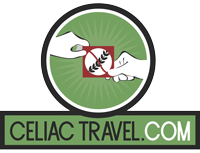Home » Friends and Family Factsheet
Celiac Travel
Friends and Family Factsheet
If you are planning to eat at the house of friends or family, this guide to coeliac/ celiac disease will help them understand how important gluten free food is to you, and how to prepare a gluten free meal.
Celiac Disease an intolerance of gluten. People with this are therefore unable to eat foods that contain gluten. Gluten is a protein present in a certain number of cereals: wheat, rye, oats and barley. Foods containing these cereals or their derivatives, such as flour, starch, bread, pasta, biscuits and cakes, all contain gluten. Gluten may also be present in less obvious foods, such as sweets, puddings, preserved meats, stock cubes, etc.
They will inevitably cause themselves serious harm, primarily to the intestine and secondarily to other organs.
The walls of the intestine are lined with minute finger like projections called villi. Intestinal villi absorb nutrients from ingested food. When a person with Celiac Disease ingests gluten, his/her villi flatten out and no longer perform their function. Nutrients in food are thus no longer assimilated and are passed out of the body in the faeces.
Those with Celiac Disease who ingest gluten effectively put their intestine out of service; their bodies no longer receive the necessary nutrition and consequently they lose weight, their growth is stunted and they become ill. Symptoms vary, the most noticeable being diarrhoea, abdominal swelling, loss of appetite and vomiting. However, sufferers may also develop other less immediately apparent symptoms, such as iron and calcium deficiency.
The only treatment required is a gluten-free diet. It might seem difficult at first to enjoy a complete and balanced diet without gluten, but in fact, providing you follow certain specific rules, it is really relatively simple.
People with Celiac Disease can still follow a healthy, balanced diet with variety and taste. The important thing is that none of the food they eat must contain gluten (not even tiny amounts), or be cross-contaminated by gluten containing food. Those affected must stick rigidly to a gluten-free diet for life.
Food a Celiac can eat:
- Rice, maize, potatoes, all kinds of vegetables and fruit, eggs, cheese, milk, meat and fish, nuts, seeds, pulses and beans as long as they are not cooked with wheat flour, batter, breadcrumbs or sauces.
- Any food specifically labelled as gluten free.
- Wine.
Food that may make a Celiac ill
- Any food that contains flours or grains of wheat, rye, barley and oats, including spelt flour.
- Marinades, sauces, mayonnaise, pickles, gravy mix.
- Pasta and couscous.
- Batter, breadcrumbs, pastry
- Soy sauce and mono-sodium glutamate (MSG)
- Stock or bouillon
- Modified starch
- Malt or malt flavouring (common ingredient in breakfast cereals) and malt vinegar.
- Any ingredient listed as a “natural flavouring”.
- Processed meat or seafood.
- There is a large list of forbidden ingredients (e.g. dextrin and malto-dextrin, citric acid), which generally are found in processed and prepared food. As a simple rule, processed and prepared foods are not allowed. Beer, grain based spirits.
Cross-contamination can be avoided if you are careful in the kitchen. For example, grills must be cleaned before cooking, toasters not used unless scrupulously clean, separate stirring spoons used etc. Toast crumbs in the butter or jam are a common source of contamination.
